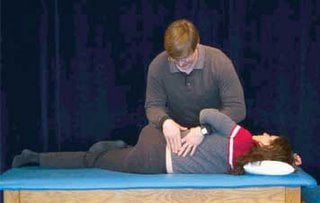OMT treatment techniques : High Velocity-Low Amplitude (HVLA)
Source: www.acofp.org/member_publications/omt_6.html
Note: This blog author feels that www.acofp.org/member_publications is the best website today for OMT techniques.
The goal of Osteopathic Manipulative Treatment (OMT) is to restore motion and balance to affected areas of the musculoskeletal system. With balance, fluid and healing elements can return to the area and the toxic byproducts of injury can be drained away. To do this we use a variety of techniques:

Note: Picture taken from ACOFP website.
Thrust Technique
In this form of manipulation, the physician applies a high velocity/low amplitude force to restore specific joint motion. With such a technique, the joint regains its normal range of motion and resets neural reflexes. The procedure reduces and/or completely nullifies the physical signs of somatic dysfunction tissue changes, asymmetry, restriction of motion and tenderness.
Example:
High Velocity-Low Amplitude (HVLA): In this technique the physician uses his or her hands to find joints that are not moving as well as or symmetrically with other joints. He or she then engages the barrier to motion in the joint and uses a quick but short thrust to overcome that barrier. Often a popping noise will ensue as motion is restored to the joint.
HVLA is a general type of manipulative treatment that involves a quick thrust over a short distance through what is termed a pathologic barrier. The movement is within a joint's normal range of motion and does not exceed the anatomic barrier or range of motion. With proper positioning of the patient, high-velocity-low-amplitude requires very little force and can be specifically targeted to spinal segments. The goal of the treatment is restoration of joint play or a desirable gap between articulating surfaces.
Of all the osteopathic techniques, high-velocity-low-amplitude most closely resembles the chiropractic technique and has the greatest number of contraindications, including rheumatoid arthritic involvement of the cervical spine, carotid or vertebrobasilar vascular disease, the presence or possibility of bony metastasis or severe osteopenia, and a history of pathological fractures. One difference between osteopathic manipulative therapy and chiropractic therapy is that chiropractors may manipulate an affected joint beyond its physiologic and anatomic range of motion. Doctors of osteopathy look for restrictions within the normal or physiologic range of motion of the joint and attempt to correct them by moving the joint through the abnormal pathologic barrier, usually not beyond the physiologic range. This may explain the low incidence of adverse effects from OMM.
HVLA is a general type of manipulative treatment that involves a quick thrust over a short distance through what is termed a pathologic barrier. The movement is within a joint's normal range of motion and does not exceed the anatomic barrier or range of motion. With proper positioning of the patient, high-velocity-low-amplitude requires very little force and can be specifically targeted to spinal segments. The goal of the treatment is restoration of joint play or a desirable gap between articulating surfaces.
Of all the osteopathic techniques, high-velocity-low-amplitude most closely resembles the chiropractic technique and has the greatest number of contraindications, including rheumatoid arthritic involvement of the cervical spine, carotid or vertebrobasilar vascular disease, the presence or possibility of bony metastasis or severe osteopenia, and a history of pathological fractures. One difference between osteopathic manipulative therapy and chiropractic therapy is that chiropractors may manipulate an affected joint beyond its physiologic and anatomic range of motion. Doctors of osteopathy look for restrictions within the normal or physiologic range of motion of the joint and attempt to correct them by moving the joint through the abnormal pathologic barrier, usually not beyond the physiologic range. This may explain the low incidence of adverse effects from OMM.
Modified Upper Thoracic HVLA Techniques in Action:
Source: ACOFP Website
Procedure:
Using chest as Fulcrum, as she breathes in, she’ll fall back on you. At end of expiration, take hands over elbows and thrust toward your head using your chest. Take hands and thrust up through the hands and use the chest to push forward.



0 Comments:
Post a Comment
<< Home